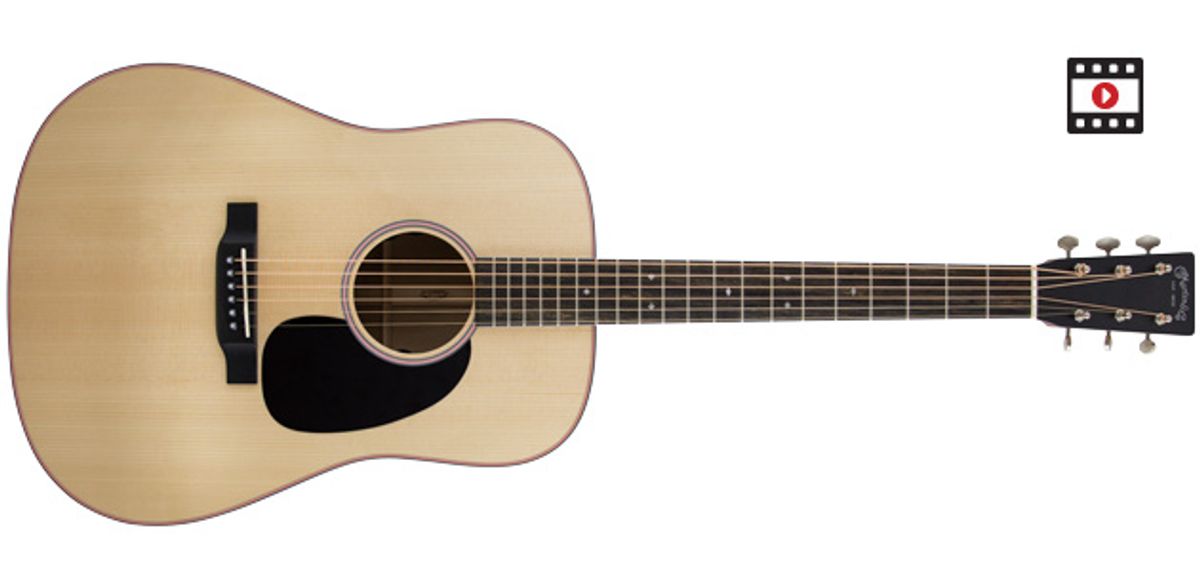New twists on Martin tradition deliver sonorous, stylish dividends.
I’ll admit I was just a little taken aback when I first removed Martin’s new D-16E from its hardshell case. The guitar isn’t trimmed with the traditional tortoise or herringbone binding. Instead, this dreadnought entry from Martin’s new Americana series is bound in matte silver with a matching heel cap. Subtle, but just a bit flashy, I wondered if it marked some new more radical direction for Martin. Yet it only takes a few strums and leads to hear that the spruce-and-sycamore D-16E maintains the classic Martin tone pedigree—strong in the bass frequencies and full of thump. Better still, it’s a beautifully playable and comfortable dreadnought.
New Nazareth Boogie
Silver binding isn’t the only 16-series design departure. The dreadnought-sized body is shallower than a classic Martin dread’—using 000 body depth dimensions instead. It’s built around a Sitka spruce top, but the back and sides are sycamore. While it’s not a household name as far as tonewoods go, sycamore grows abundantly across the United States and falls somewhere between mahogany and maple when it comes to density and mahogany’s dark and maple’s bright tonality. It’s a sustainable alternative to classic choices like rosewood and mahogany, which are becoming scarcer. The sycamore on the review model is attractive, too—with a wavy grain pattern and a rich brown coloring.
wide range of styles.
The D-16E might cost a bit less than its 18- and 28-series counterparts, but it’s no less nicely built than other high-end Martins I’ve played recently. The craftsmanship is meticulous, to say the least, both inside and outside of the box. The binding and purfling work is totally clean, without a hint of excess glue. The gloss finish is perfect. Copious care has been taken with the frets, too, which are perfectly crowned and polished.
Playability is similarly impeccable. It’s intonated precisely, and there are no buzzes or dead spots anywhere on the neck. The neck shape is what many players consider Martin’s most comfortable profile—a modified low oval with a “high performance” taper. This isn’t hyperbole on Martin’s part. The neck feels sleek and fast, and so does the factory-set action.
Balance Before Boom
The word “cannon” is often used to describe coveted prewar and modern high-end Martin dreadnoughts. The D-16E’s responsiveness isn’t exactly that explosive. And it probably wouldn’t be the first choice for, say, an unplugged bluegrass jam. But what it lacks in heavy impact—a tone quirk that might be related to the shallower body and the sycamore back and sides—it makes up for in clarity and balance. It’s got a lean and uncluttered sound and gracefully balances overtones and fundamentals, which works well for a wide range of styles.
Ratings
Pros:
Beautifully built. High-quality electronics. Cool styling deviations from Martin norms.
Cons:
Slightly less responsive than some high-end Martin guitars.
Tones:
Playability:
Build/Design:
Value:
Street:
$2,159
C.F. Martin & Company D-16E
martinguitar.com
Whether in standard tuning, open G, or open D, the D-16E is great for strumming. Some dreadnoughts can be too bass-heavy, but that’s not the case with this guitar. I can clearly hear individual notes in simple and complex chords alike, and the D-16E is even detailed enough to excel in chord-melody jazz arrangements.
Though I had to dig in a little more with the pick-hand fingers on the D-16E to generate the same snap that I would on, say, a Martin OM-28, this dreadnought is still great for fingerpicking. Cascading arpeggios in DADGAD sound particularly rich on the D-16E, though ringing open tunings with lots of octave overtones can make the D-16E feel just a little buttoned-up. It will be interesting to hear how the guitar seasons in the years to come.
Amplified, the Matrix VT Enhance system delivers an excellent representation of the guitar’s natural acoustic sound. The pickup and preamp are quiet and resistant to feedback, and they minimize unwanted transients like string squeak and body noise, making the system a great solution both for gigging and recording.
The Verdict
There are plenty of good steel-string options available these days—and a lot of great ones for north of two grand. But the D-16E still manages to stand out in this price class, thanks to easy playability, sparkling tonal consistency, and plug-and-play gig readiness. With subtly unique styling, the D-16E is classic Martin in every sense and full of fresh ideas, too.
Watch the Review Demo:


